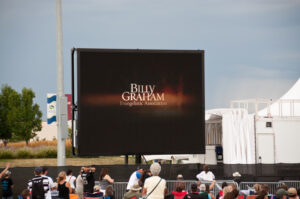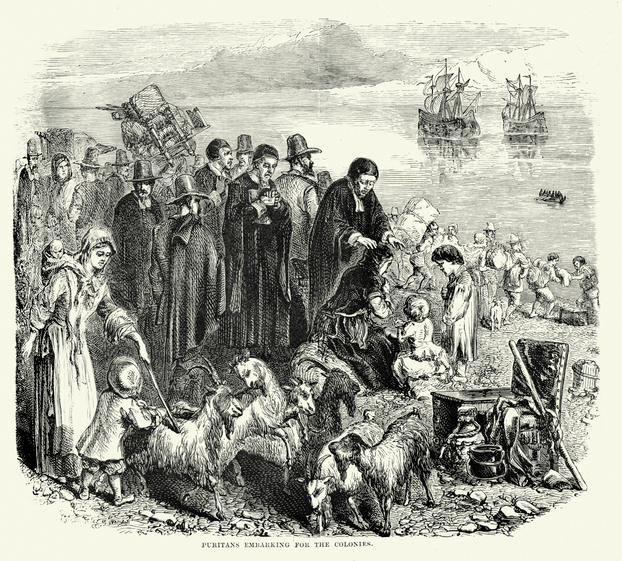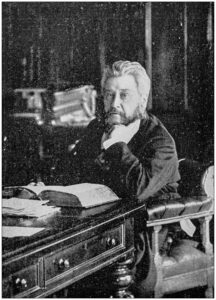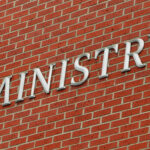
We praise the Thee, O God! For the Son of Thy love, For Jesus Who died, and is now gone above. Hallelujah! Thine the glory. Hallelujah! Amen. Hallelujah! Thine the glory. Revive us again.
~ “Revive Us Again” church hymnal
Church revivals, also called revival meetings, are religious services within the Christian church that are held to inspire, or reawaken, the spiritual vigor of a group of believers. Historically, revival meetings have been held for Christian communities and churches, that tend to be largely Protestant. Church revivals serve two, main purposes:
- Revitalize the spiritual life of its members
- Gain new followers
A church revival involves a group of Christians praying and seeking the Holy Spirit’s presence together while rejoicing over a renewed spiritual exuberance. The purpose of a church revival is to allow the power of the Holy Spirit to transform both believers and nonbelievers alike. Through revival meetings, people sense the power of God and are called to prayer and repentance.
Explore a Christian Ministry Degree – Request More Info Today!
According to the Bible, God has the ability to bring his people back to life and restore their souls when they begin to fall away from their faith…
“Now restore us again, O God of our salvation. Put aside your anger against us once more. Will you be angry with us always? Will you prolong your wrath to all generations? Won’t you revive us again, so your people can rejoice in you? Show us your unfailing love, O Lord, and grant us your salvation”
~Psalms 85: 4-7
Church revivals are held in churches, missionary organizations, and campus, all with the singular purpose of renewing the spiritual life of its believers for restoration and renewal.
“The high and lofty one who lives in eternity, the Holy One, says this: I live in the high and holy place with those whose spirits are contrite and humble. I restore the crushed spirit of the humble and revive the courage of those with repentant hearts”
~Isaiah 57:15
Billy Graham – America’s Pastor
“We are the Bibles the world is reading; We are the creeds the world is needing; We are the sermons the world is heeding.”
 Billy Graham preached the Gospel to more people than anyone else in history. It is estimated that he reached 215 million people in more than 185 countries and territories, along with countless people through television and film.
Billy Graham preached the Gospel to more people than anyone else in history. It is estimated that he reached 215 million people in more than 185 countries and territories, along with countless people through television and film.
Born in 1918 in Charlotte, North Carolina, Graham began preaching in the Southern Baptist Church early in his life. In his mid-twenties, he worked for Youth for Christ International, an evangelical movement. He traveled throughout U.S. and England, teaching local church leaders how to organize youth rallies.
He began nationally publicized crusades just a few years later and began a radio program called the “Hour of Decision.” Massive, weeks-long revivals in London, New York and Asia followed, along with the founding of his magazine, Christianity Today and several nationwide television broadcasts.
His popularity and reputation as the face of evangelical Christianity made him a favorite among many U.S. presidents. He served as pastor, preacher, and counselor to Presidents Truman, Eisenhower, Kennedy, Nixon, Ford, Carter, Reagan, Bush (41, 43), Clinton and Obama.
The History of the Church Revival
1734 - Church revivals (also called awakenings) have a long history in the Protestant church, starting with the Great Awakening. The first recorded revival occurred in December 1734 in Northampton, Massachusetts. Jonathan Edwards, the town’s Congregational pastor, preached a sermon series on justification by faith alone. The townspeople responded in favor, and within six months, Edwards noted that he had converted three hundred people.
 1739 - Building on Edwards’ success, revivals began breaking out in nearby towns and by 1739, George Whitfield set out on a preaching tour of the American colonies. He made Philadelphia his first stop, and thousands came to see him. Every stop be he made on his tour was marked by record audiences who came to hear of the “divine things” Whitfield was preaching. It is estimated that nearly 80 percent of America’s 900,000 colonists heard Whitfield preach.
1739 - Building on Edwards’ success, revivals began breaking out in nearby towns and by 1739, George Whitfield set out on a preaching tour of the American colonies. He made Philadelphia his first stop, and thousands came to see him. Every stop be he made on his tour was marked by record audiences who came to hear of the “divine things” Whitfield was preaching. It is estimated that nearly 80 percent of America’s 900,000 colonists heard Whitfield preach.
1800s - A renewed enthusiasm for revivals occurred in the Second Great Awakening, a Protestant religious revival in America that ran from about 1800-1835. The Second Great Awakening was marked by camp meetings, outdoor revival meetings held on the American frontier. Those attending these camp meetings came from as far as 40 miles away and camped out for three to four days for religious worship. As many as 20,000 people would attend a camp meeting, gathering for preaching, prayer meetings, singing, baptisms, and weddings. Thanks to these gatherings, the Methodist and Baptist churches experienced significant increases in membership.
1831 - The second phase of the Great Awakening was marked by Congregational theologians like Timothy Dwight, Lyman Beecher, Nathaniel W. Taylor, and Asahel Nettleton, and Charles Finney. Finney is largely credited with spurring the crusades for anti-slavery, women’s rights, prison reform, temperance, and more. He was known for his informal, fiery preaching style that attracted large congregations and an increasing number of converts in the largest cities across the U.S. It is estimated that Finney converted 500,000 to Christ in his time. In Rochester, New York, alone, an estimated 100,000 people were converted after his 1831 revival.
1835 - In Lectures on Revival of Religion (1835), which contains 23 of his lectures, Finney wrote that a revival is necessary when the following occurs: “First, when the providence of God indicates that a revival is at hand... Second, where the wickedness of the wicked grieves, humbles, and distresses Christians... Third, when Christians have a spirit of prayer for revival... And lastly, when believers have a desire and anxiety to a call of repentance and to a new or fresh obedience to God.”
1857 - Other revivals followed, including the Great Prayer Meeting Revival in 1857, which added an estimated one million converts, and the Civil War Revival which, by 1862, added about 300,000 solider converts.
1906 - The Azusa Street Revival of 1906 was brought about when William J. Seymour, an African-American Holiness pastor, began prayer meetings in Los Angeles that drew massive interracial crowds so large that they soon acquired a Methodist church on Azusa Street and conducted daily meetings there for three years. This revival movement was characterized by miracles, speaking in tongues, and spirited worship services. It is also considered to be the catalyst for the Pentecostal and Charismatic movements in the 20th century.
1949 - The Post-World War II Awakening was actual two Pentecostal awakenings: the Latter Rain Revival and the Healing Revival. By 1949, Billy Graham became a major voice in the evangelical Christian movement. It is estimated that more than 180 million people attended his 400+ crusades, many of which were televised.
1960s -1970s - The 1960s and early 1970s saw the Charismatic Renewal and Jesus Movement, both of which reached beyond just the Pentecostal and Holiness churches and to college campuses and mainline denominations. In 1976, America elected Jimmy Carter, a born again president.
 1990s - More recently, church revivals included the Toronto Blessing in 1994, the Melbourne Revival, the Modesto Revival, and the Brownsville Revival in 1995 that recorded about 100,000 conversions in just two years. College revivals soon followed, inspired by the revival at Howard Payne University in Brownwood, Texas.
1990s - More recently, church revivals included the Toronto Blessing in 1994, the Melbourne Revival, the Modesto Revival, and the Brownsville Revival in 1995 that recorded about 100,000 conversions in just two years. College revivals soon followed, inspired by the revival at Howard Payne University in Brownwood, Texas.
The Promise Keepers Revival of 1991, which involved a group of more than 4,000 men who came to the University of Colorado to be challenged to live up to their faith, became a global movement, and on 1997, an estimated 1 million men gathered on the National Mall in Washington DC to take a stand for Christ. The Promise Keepers evangelical movement continues today with the goal of bringing about “revival through a global movement that calls men back to courageous, bold leadership.”
Charles Spurgeon – The Prince of Preachers
 Charles Haddon Spurgeon (1834-1892) was a Victorian, Calvinist, Baptist minister who preached from the time he was just 16. Within a few years, his sermons attracted hundreds and then thousands. By the time he was 22, he had gained mass appeal, becoming one of the most famous orators of his time. His ministry inspired revival and remain a priority for him throughout his life. It is estimated that during his time, the attendance of London’s Protestant churches increased by 60 percent.
Charles Haddon Spurgeon (1834-1892) was a Victorian, Calvinist, Baptist minister who preached from the time he was just 16. Within a few years, his sermons attracted hundreds and then thousands. By the time he was 22, he had gained mass appeal, becoming one of the most famous orators of his time. His ministry inspired revival and remain a priority for him throughout his life. It is estimated that during his time, the attendance of London’s Protestant churches increased by 60 percent.
His sermons and publications were often focused on the spirit of revival. Just some of his observations on the power of revival include:
“Many blessings may come to the unconverted in consequence of a revival among Christians, but the revival itself has to do only with those who already possess spiritual life.”
“Revival is to live again, to receive again a life which has almost expired, to rekindle into a flame the vital spark which was nearly extinguished.”
“If we want revivals, we must revive our reverence for the Word of God.”









